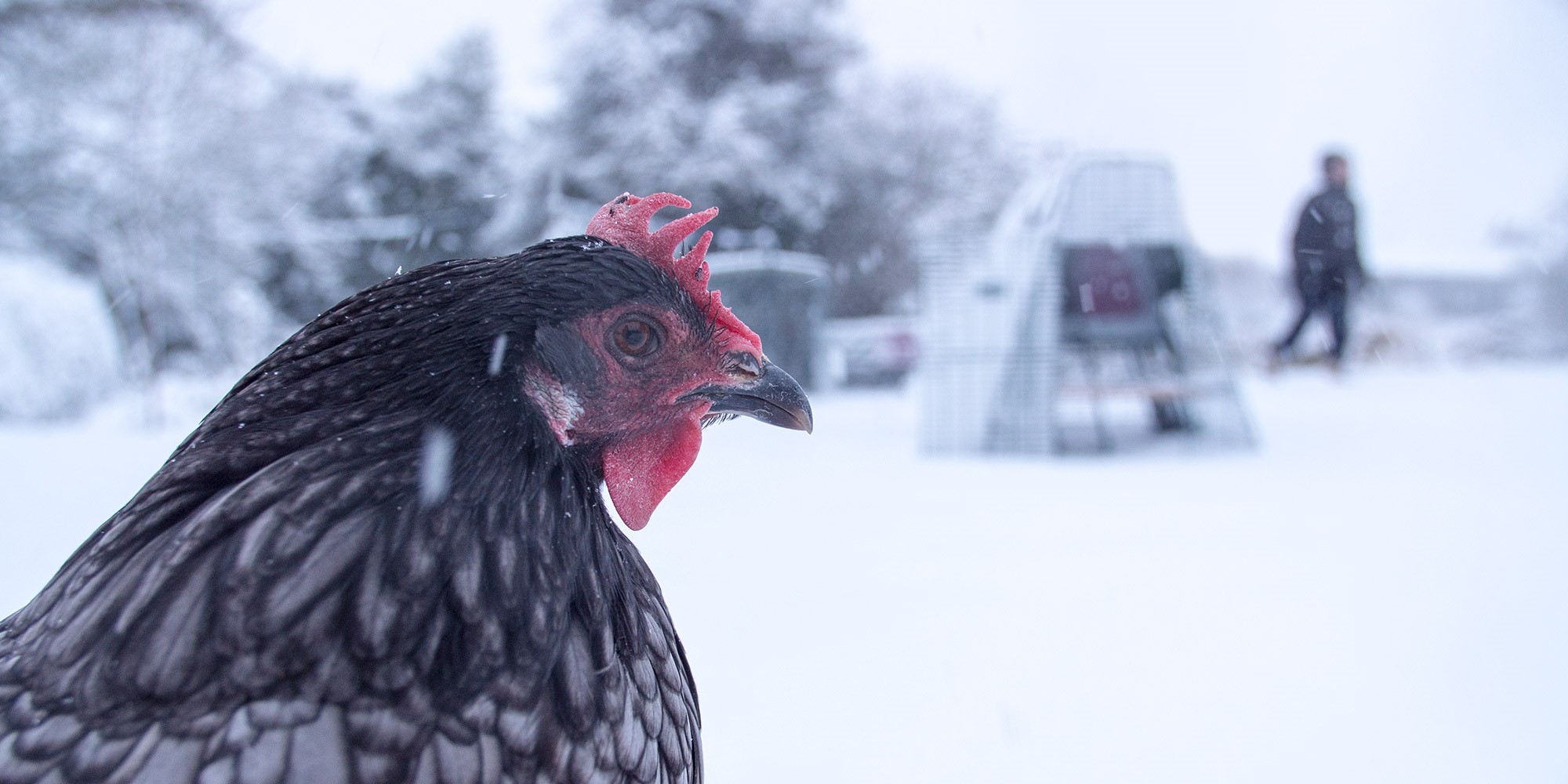
Snowy weather can bring great fun for all the family, but when it comes to our pets we need to take extra care to keep them happy and healthy (even if they love it!) Take a look at our snow safety advice, and make sure you’re prepared for whatever winter may bring…
Dry off damp fur and feathers
Check on your outdoor pets a few times throughout the day during periods of snowy weather and check they haven’t got too wet. Damp fur and feathers will take longer to dry during colder temperatures, making it difficult for them to warm up again. Indoor animals should also be dried off with a towel after being outside or going for a walk.
Clean paws of ice
For dogs and cats in particular, snow can get compacted into their paw pads and turn to painful cubes of ice. Use a towel or drying mitt to dislodge any chunks of snow and dry off their feet. Also take care when walking your dogs in snow, as salt used to grit the roads can be poisonous. Watch that they don’t stop to eat snow at the roadside and clean their legs and paws of any snow or dirt after their walk.
Extra food
Pets of all kinds will use more energy to keep themselves warm in winter, particularly in super cold, snowy spells, so they will benefit from some extra food. Although they will appreciate more treats, don’t be tempted to overfeed on these. Something nutritious will help them the most.
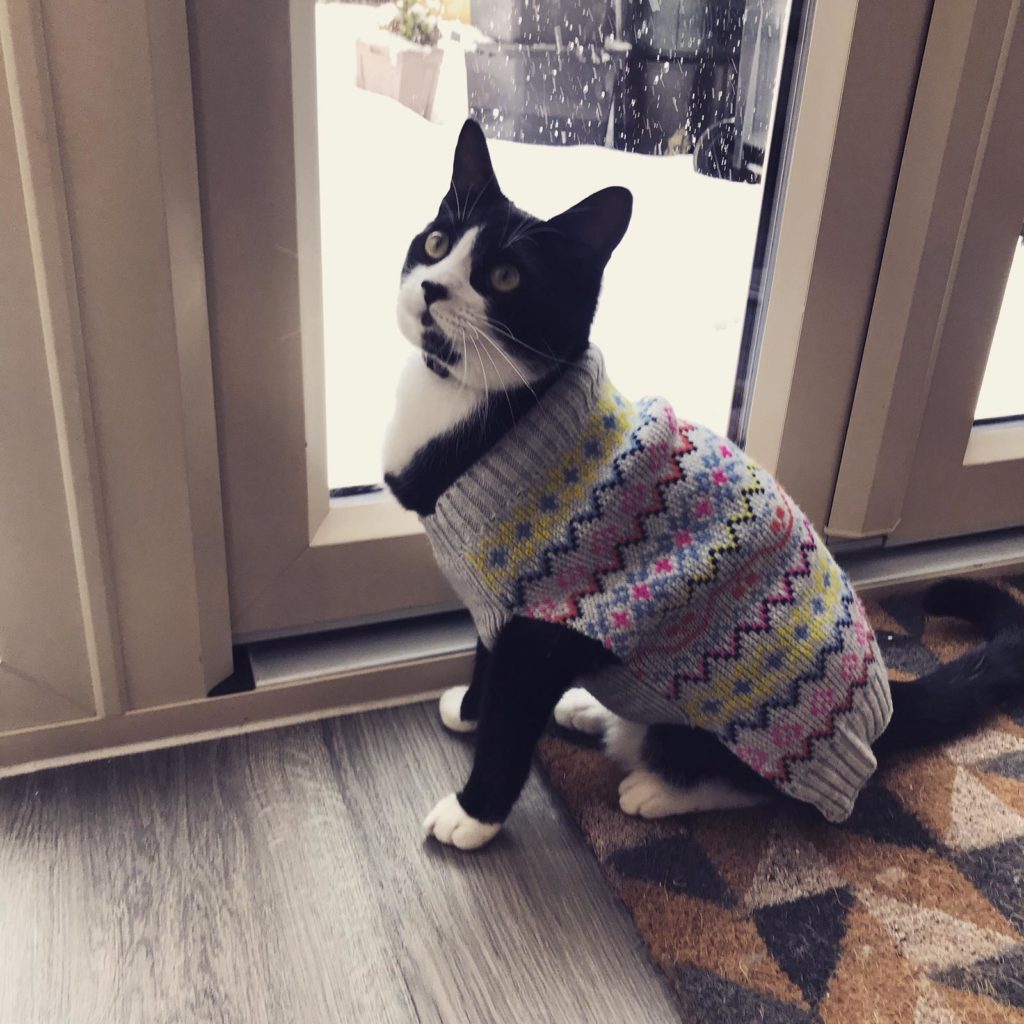
Extra bedding
Outdoor pets will need more dry bedding in their coop or hutch for them to snuggle into and keep warm. However, make sure their home is still well ventilated to keep fresh air moving through and prevent health problems. Read other ways you can get your coop winter-ready. Indoor animals might also appreciate an extra blanket or a cosy den for bedtime.
Potential risks
If you have a cat who still likes to go outdoors whatever the weather, be wary of the potential of antifreeze poisoning. Look out for symptoms such as vomiting, seizures or difficulty breathing and call a vet immediately if you think your cat may be ill. An outdoor enclosure could also provide a solution for letting them play outside in safety.
Don’t forget about the wild birds in your garden!
Place a wide bowl or tray of water in your garden with something inside to float around (e.g. rubber duck!) to keep the water moving and prevent freezing. Extra wild bird food will also be appreciated!
This entry was posted in Cats on June 29th, 2020 by linnearask
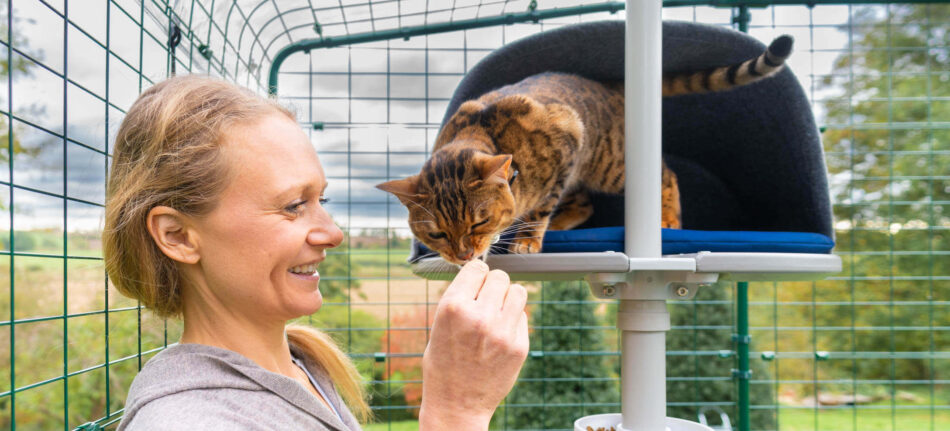
Have you ever felt that the missing piece to your life puzzle was a four-legged furry companion with whiskers and a tail? We get it. Owning a cat is one of life’s greatest pleasures.
But how do you know when is the best time to get a cat? Read on to find out all the answers to your questions to help you decide if you are ready to become a cat owner.
Questions to ask yourself before getting a cat
Do I have enough time?
One of the greatest attributes of cats is that they’re pretty independent. But while they don’t demand a lot of attention, they should also not be left alone for long periods of time. Why? Cats can be like kids in that way. Left to their own devices for too long and things might get, well, messy.
So if you’re thinking about getting a cat, make sure you have a schedule that allows you enough time to devote to your new furry feline. It’s ok if you have to leave every day to go to work, as long as you’re at home in the mornings and evenings for kitty playtime. If, however, your job requires you to travel away from home often, you might want to consider waiting until you have a more consistent schedule before bringing a cat into the mix.
Do any family members have allergies?
Most people know if they have allergies to certain foods or things in their environment. But unless you’ve ever been around a cat for an extended period of time, you may not know if you’re allergic to them. And since studies show that a third of the US population has some type of allergy to cats, it’s always good to know about the members of your family before adding one to the brood.
But how can you know if you’re allergic to cats before owning one? Simple. Go visit a local animal shelter and ask to spend some time with the cats. Or, if you have a friend who owns a cat, ask to spend some time at their house to see if you have any reaction. If you or any other member of your family does indeed have an allergy to cats, you’ll know very quickly after spending just a little time with them. Watch out for itchy eyes, sneezing or even skin irritations – if any of these start to happen, you might have a cat allergy.
So does that mean I can’t own a cat? Not at all! There are many cat breeds like Sphynx, Bengal and Siamese that are relatively ‘hypoallergenic’ for people with mild cat allergies. So your dreams of having a feline friend can still come true!
Can I keep up with the upkeep?
Cats are notoriously one of the most low maintenance pets to own. But that doesn’t mean owning a cat requires no effort on your part. If you’re thinking about getting a cat, you must first ask yourself if you’re ready to be a pet parent. Here’s what that involves:
- Regular cleaning of the cat litter box. It’s a dirty little job, but someone’s gotta do it!
- Hairball picker upper. Cats and hairballs go hand in hand and often in the most unsuspecting places.
- Beauty groomer. While cats are naturally pretty self-sufficient in cleaning themselves, regular brushing and nail trimming is still something they need help with.
- Lots of love – because really that’s the best part of owning a cat!
Do I live in a cat-friendly place?
Cats are creatures of habit and will find their own cat space within your home. That being said, it’s important to make sure that where you live is accommodating to cats. If you live in an apartment or condo where you rent, be sure to ask if having cats in your place is allowed.
You also want to ensure your interior space is conducive to cat living. Small spaces need not scare you away from owning a cat as there are many products to help you still entertain your cat and not feel too cramped.
Is your living room adorned with beautiful leather furniture? If so, you definitely want to invest in a cat tree and scratcher so your furry friend exercises their nails on something other than your sofa. No space is too big or too small for cats as long as you are prepared.
Do I have any major life events looming?
Before deciding to add a four-legged member to your two-legged family, you need to first assess your current life circumstances. While you can’t always predict the ebbs and flow of life, you want to make sure you are not about to embark on any big life changes when thinking about getting a cat.
Upcoming moves or new jobs that require heavy travel may prohibit your ability to give your new cat the attention and time they need. Cats need consistency at the beginning of their new life with you to feel comfortable and at ease. This is why you also want to avoid bringing home a new cat during big celebrations like birthdays, Christmas or Fourth of July. Best rule of thumb? Wait until all is calm on the domestic front before bringing home a new cat.
Best place to get a cat?
If your answers to all the questions above are still pointing you in the direction of cat ownership, congratulations! The next decision you need to make is where are you going to get a cat. There are a plethora of options when it comes to choosing the best cat for you: breeders, pet store, rescue/shelter and even family and friends.
We highly recommend rescuing a cat from a shelter or rescue organization for a variety of reasons:
- Typically the adoption cost is much less.
- Most cat adoptions from rescues or shelters include vaccinations, neuter/spay, and even a first free visit to a local veterinarian.
- Most cats at a rescue or shelter are of the “mixed-breed” variety and these cats tend to actually live longer, healthier lives than their pure breed counterparts.
- But most importantly, you’ll be saving a life.
Certainly, if you have identified a real cat allergy in yourself or other family members but still long for a feline friend, going through a breeder of a specific hypoallergenic breed would be best. Regardless of where you get your cat from, you are sure to receive far more love in return.
Everything you need for your new cat
Once you have identified it’s the right time for you to get a cat, the real fun begins. Having the essential cat products at home when your feline friend arrives will make their adjustment that much easier. Here is a list of everything you need for your new cat:
- Litter box: Cats need their private bathroom space, too. The Maya Cat Litter Box from Omlet gives your cat the discreet potty breaks they crave while also minimizing the mess of kitty litter on your floor. Plus it looks great in your home, too.
- Donut cat bed: You’ll quickly learn that cat napping is a real thing. And since you want your cat to be as comfortable and cozy as possible, you want to make sure they have a snuggly sleep spot to catch all their zzzs.
- Cat tree: Cats are curious. Their need to explore, jump, climb and scratch is imperative to their existence. So give them what they need and get them an indoor climbing wonderland that will enhance their curiosities.
- Outdoor cat enclosure: Can my new cat play outside? Absolutely. With the Catio designed by Omlet, senses are heightened and freedoms are found as your cat safely explores the outside world.
Knowing the best time to get a cat comes down to knowing if you are ready to commit to the time and resources needed. Taking the time to ask yourself these questions and prepare accordingly will make your relationship with your new cat all the more enjoyable. So, all that is left to answer is, are you ready to get a cat?
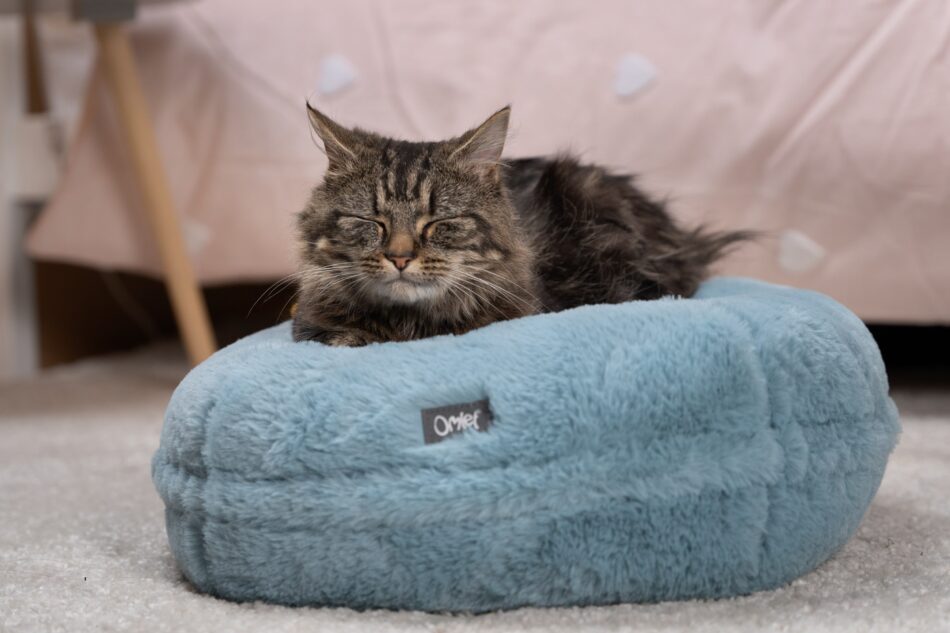
This entry was posted in Cats on June 22nd, 2020 by linnearask
Winter brings unique challenges for chicken keeping, and avoiding common pitfalls can help keep your flock healthy and thriving. In this guide, we’ll discuss the 10 things to avoid as a winter chicken keeper, helping you navigate the season with confidence and care. From managing coop conditions to understanding your hens’ needs, these insights will ensure you’re prepared for the cold months ahead.
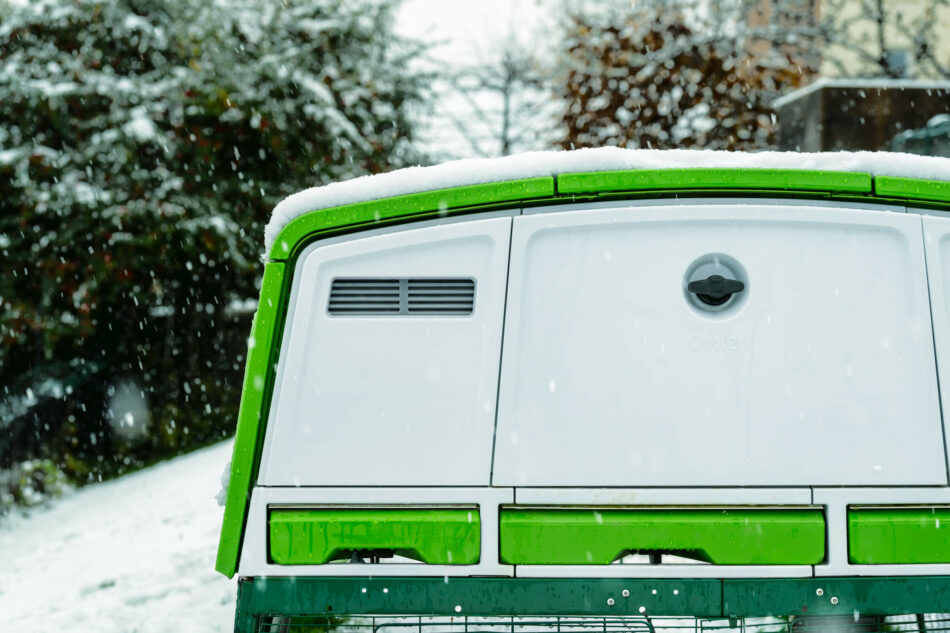
What to avoid this winter
Knowing what to avoid is as important as knowing the right things to do when caring for your chickens. Preparing for winter is a necessary task when tending to your flock, but there are some things that may be overlooked or misunderstood about winter chicken-keeping. Here’s what not to do this season.
Don’t coop your chickens up
Chickens are built to be outside, and they’re known for withstanding cold temperatures. In fact, a hens’ normal temperature runs around 105°F, so enduring the cold is much easier for them than the heat. And, underneath a chicken’s shiny plumage lies dense, downy feathers to insulate them — courtesy of your flock’s annual moult that takes place in the fall.
While it may be tempting to keep your chickens fully enclosed in their coop, they’ll quickly become bored and agitated. Instead of keeping a lock and key on their coop, open their coop door after the sun has been up for a couple of hours to help warm their environment, or program your Smart Autodoor to open at a specified time. Invest in chicken run covers to prevent snow and ice from accumulating, and offer plenty of chicken perches to help warm their feet up off of the frozen ground. With these provisions in place, your flock will be well supported outside of their coop.
Don’t make their coop airtight
Another common mistake chicken keepers make is trying to seal their chicken coops. Your flock needs fresh air to circulate throughout their coop to prevent moisture buildup and respiratory illness. Insulated chicken coops keep the harsh elements out while still allowing for the right amount of air circulation to prevent these issues.
Drafts are a valid concern in the winter, but well-designed ventilation will not allow for cold drafts to permeate the coop. Even with extreme temperature chicken coop jackets, Omlet’s Eglu Chicken Coops allow just the right amount of fresh air to circulate without creating dangerous drafts. Now that’s a breath of fresh air for winter chicken-keeping.
Don’t offer supplemental heat
Chickens are hardy and will adapt to the lower temperatures as they gradually decline. If their coop is heated, they will miss out on this natural process, and will be shocked — quite literally — if they stride out into freezing temperatures from a balmy coop. This sudden, extreme change in temperature can cause a chicken to go into shock and can result in the death of your flock.
Heat sources are also a fire hazard, and should not be used without being closely supervised. Brooder plates, heat lamps, or heating pads are appropriate for sick flock members or young chicks, but should be used only in dire situations for healthy hens. Extra insulating bedding like straw or hay can be added to nesting boxes and roosting areas to provide additional warmth in lieu of electric heat sources.
Don’t leave eggs in the coop
While it may be easy to remember to gather eggs in the dog days of summer before they spoil, it’s important to gather eggs quickly when the temperatures reach freezing. Eggs shouldn’t be left in the coop for more than a couple of hours if the temperatures are below freezing. A frozen egg isn’t ruined, but the contents will expand the longer it’s allowed to freeze, which will crack the shell. Once the shell is compromised, bacteria can enter the egg freely, making it inedible.
Get into the habit of looking for and collecting eggs each time you visit the coop. This is a good rule in any season, but especially during periods of extreme temperatures.
Chicken waterers can quickly turn to popsicles when the temperatures reach freezing. You’ll need to break the ice in a very literal way throughout the day for your flock to maintain their water source. Pouring warm water over frozen waterers can also thaw them, or consider using electric bird bath heaters or other types of submersible heaters in their waterers. Be sure to keep cords and components out of your flock’s reach.
Putting a floating object in their water like a tennis ball can also help prevent ice from forming. The constant movement will break up the ice formation so it won’t be able to freeze solid. This has mixed results based on the size of the object, amount of wind, and other factors, but it’s a safe method to experiment with.
Don’t put off cleaning the coop
Before the temperatures plummet, give your chicken coop a deep clean. This will allow you to use a pressure washer without the threat of ice one last time before the freeze sets in. Refresh the bedding with thick, warm bedding like shavings or straw, and check to make sure runs covers are adjusted and secure.
Once it’s impractical to clean with water, you can keep your coop clean with a rag or stiff bristled brush. Empty the droppings trays as usual, and brush off any debris from their roosting and nesting areas. Keeping your chickens’ coop fresh and clean will promote good respiratory health over the winter.
Your chickens may not venture as far from their coop as before, largely because of the lack of insects or vegetation to pique their interest. If your property becomes covered with snow or ice, it can put an even bigger damper on their fun. To combat this potential for boredom, make sure your hens have plenty to do to occupy their days.
Chicken perches, peck toys, treat holders, or a Chicken Swing are all elements that transform winter days from dull to delightful. Use them in their run, or out in their freeranging space to create pockets of fun in an otherwise frozen world. It’ll cheer your heart along with your hens.
Don’t go easy on the feed
Your chickens will be hungrier during the winter months. The increased demand for body heat requires their already-fast metabolisms to work harder. With these larger appetites, you can expect to fill their chicken feeders more often.
Your flock will also appreciate extra treats and nutrition during this time. Add dried mealworms or soldier fly larvae to their scratch grains, offer alfalfa hay, or make them a warm chicken mash to help satisfy their cravings.
Don’t forget combs and wattles
Any chickens can fall victim to frostbite, but hens with large combs and wattles are especially at risk. Signs of frostbite on a chicken’s comb or wattles include:
- Pale or white appearance
- Black spots or sections
- Mishapen edges
Petroleum jelly applied to these parts will help prevent frostbite from forming. Frostbite isn’t deadly to chickens, but it is uncomfortable, and once the areas have become discolored, they’ll likely fall off, leaving hens with misshapen combs or wattles.
Don’t forget chicken self-care
Sunbathing and chicken dust baths are favorite pastimes for hens in the warmer months, but when given the opportunity, your flock will enjoy this indulgence during the winter. Dust baths will help keep your hens’ feathers in good condition, keeping them fit for the task of keeping them warm. Clear run covers allow warm sun to permeate through to your flock, creating spots of warmth without the brisk chill of the wind.
Omlet and your flock
Prepare your flock for the winter with our products, designed with you and your hens in mind. Our chicken coops, run covers, and smart automatic chicken coop doors make winter chicken-keeping a breeze — not a harsh, freezing gale. This winter, work smarter, not harder, when you choose Omlet’s chicken products to support you and your flock throughout the season.
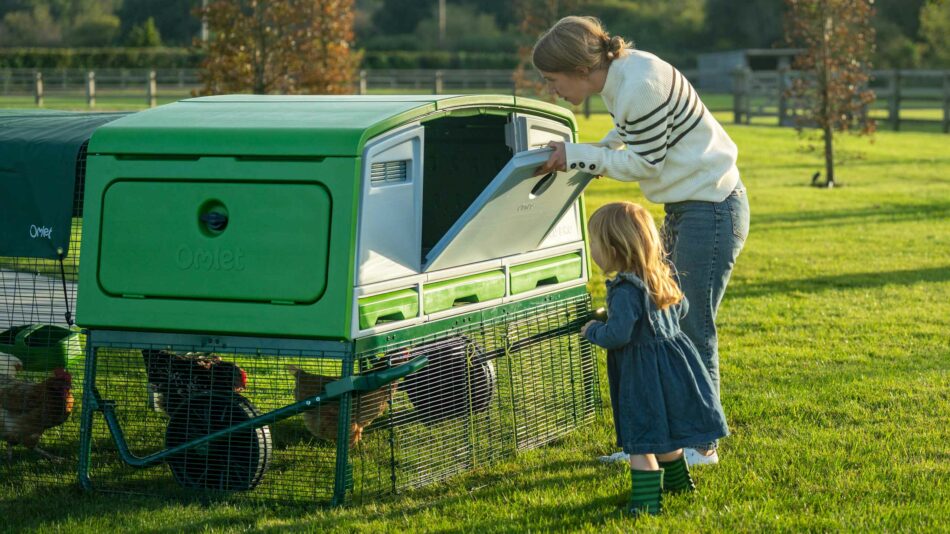

This entry was posted in Chickens on June 18th, 2020 by linnearask
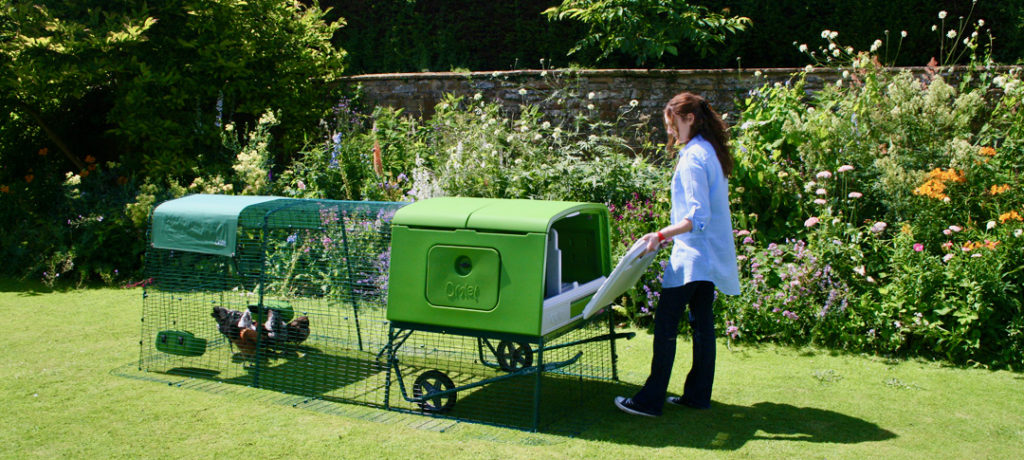
If you own and love an Omlet product and like talking to other people about your pets, then becoming an Omlet Ambassador will definitely suit you!
The Omlet Ambassador programme offers a really great way for people to not only see the products they are interested in, but also ask an owner all about it, like a live, interactive review!
If you speak to someone that then goes on to buy, you will get commission on their order. On top of that, Omlet customers in other countries have found lots of like minded friends through the Omlet Ambassador programme so it’s a great way to meet people who share your hobby in the area!
We spoke to two of our US ambassadors, Sueellen and Jennifer, about their experience of being an ambassador, and this is what they had to say:
Tell us about your chickens and your setup!
SE:
I am fortunate enough to have 2 different communities of very sweet chickens! We have 8 chickens right outside our side door and we have 23 chickens in our pasture in the backyard. We have had this arrangement for 3 years.
J:
The first is five barred rock layers. We have had them for about a year. They are in the Omlet Coop with a run and an outdoor enclosure. They get along well with each other, but won’t accept any new members. They are good sized birds but do fine in the space we have. We could increase the size of the flock no problem in the coop setup that we have.
We also have 1 white silkie, 1 blue “satin” silkie, and 2 silkie mixes (probably silkie/polish – the white one is a sizzle, the black one not sure). They are all hens except the satin. They lay but are really pets. We have had the polish/ silkies for about a year and the silkie for 6 months. The white silkie is a hen but thinks she is a rooster – his/her name is Juancho. She sings and talks all day long. Quite a character. The blue satin silkie is new to the flock. We have to be a bit more careful with them in cold weather and rain because they are so small, get wet easily and cannot fly. During the day we keep them with our Kune Kune boars Max and Luigi who help keep them safe and warm.
What do you like about your Omlet products?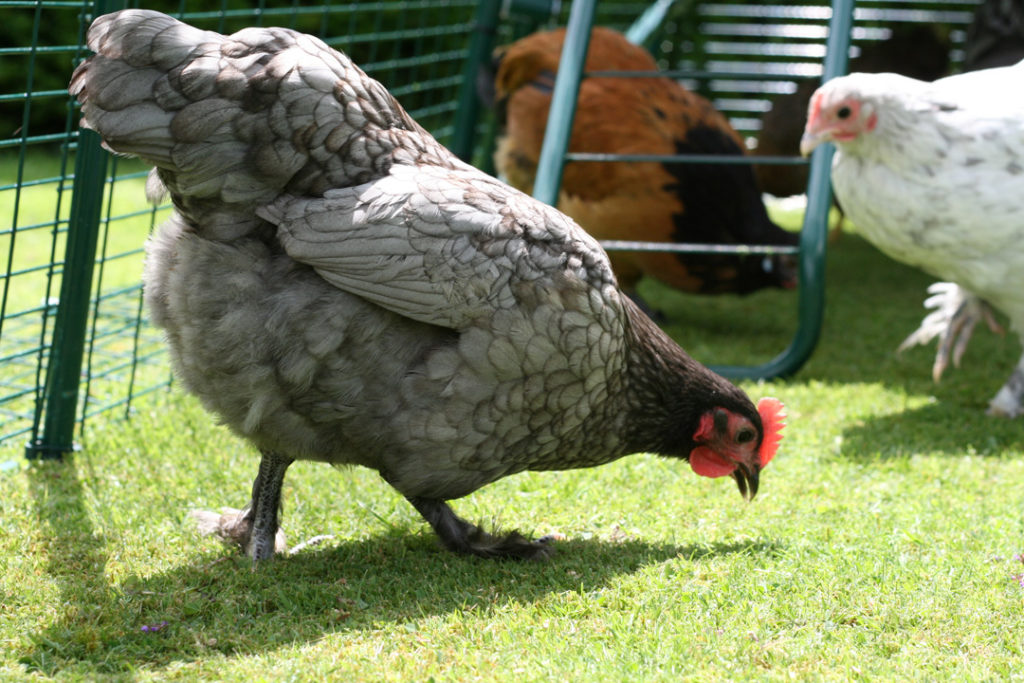
SE:
About 10 years ago we got our first chickens and the entire family (all 6 of us) loved having them. We loved their darling and hilarious personalities, and we loved getting the beautiful eggs as well. But over a short time we began to lose our chickens to many predators! It was heartbreaking to say the least! Fortunately, one of my daughters discovered the amazing Omlet products at a trade show. She told me about the Omlet coops and the pet runs and various other products! I fell in love immediately!
I love love love the way the Omlet products look. They are beautifully designed and are very easy to clean and maintain! 3 years later my coops look new! I love the pet runs especially, as they can be smaller or larger depending on your flock needs. I love that I can walk into the runs without bending down or getting on the ground. This feature enables me to easily feed, water, clean, visit and bond with my flock!
J:
We love the Omlet coop and enclosure. It’s very easy to keep clean and we have had (so far) almost no hygiene/sanitation issues. I believe that the plastic helps minimize this vs. wood or porous material. The coop is warm in the winter and stays cool in the summer even in our extreme heat. We have a lot of predators and so far, no one has been able to get in. They seem to have a hard time even getting on the coop because of the rounded roof so that is an extra plus. I also like that the product is simple – just three levers to use – simple. Everyone seems really happy and the barred rocks average an egg a day!
What’s your experience with being an Omlet ambassador?
SE:
I love being an Omlet Ambassador! I love all the products and the versatility they offer! I love my chickens! They are a sweet, hilarious and adorable part of our family. It is super fun to collect farm fresh healthy beautiful eggs everyday!
It was a very natural progression to become an Omlet Ambassador because I love the products, and I really enjoy sharing my experience, my knowledge and my love of chickens! I enjoy showing other chicken enthusiasts or others just curious about chickens our set-up!
J:
I decided to become an Omlet ambassador because I really believe in the product and my interactions with the company have been very positive – seems like a nice group of people out trying to sell a great product.
What does a normal visit or contact from a prospect look like?
SE:
Often a person considering getting chickens and/or a chicken coop will contact me by email with a few questions. We begin a dialogue and set up a visit for them to see the fabulous Omlet products at work! We choose a time convenient for both of us! Once people see the chickens and the Omlet Coops, they can’t wait to get started with their own amazing Omlet community!
J:
Pre virus, we had a few visits – everyone was very well informed (people really do their research!) and mainly wanted to see the product up close. I think part of it is the cost – it is expensive and therefore people want to make sure it’s the right thing before committing. Recently, we have had a lot of inquiries from people who are looking at getting chickens for the first time, probably driven to it by the high cost of eggs here in California. Some of them say they are a bit intimidated by the whole thing and again, want to make sure they are doing the right thing. We are definitely not chicken experts but the Omlet products help keep things simple – I am very confident that our ladies will be safe and clean, which seems to be half the battle!
If you think you would want to become an Omlet ambassador, send us an email and we will send you all the information you might need!
This entry was posted in Pets on June 12th, 2020 by linnearask

A cat’s signature move is the slinky walk with an upright tail. Intriguingly, no other cat species walks like this, and it is not known exactly when pet cats first adopted the posture.
The domestic cat’s ancestor, the African wildcat, hooked up with humans more than 10,000 years ago. They probably adopted us, rather than the other way round, attracted by the surplus of rodents nibbling away at our grain stores. It seems pretty certain that the feline freeloaders soon adapted their body language – tails included – just to please us, quickly securing their place on the sofa.
The following cat-of-nine-tails facts tell you everything you need to know about your pet cat’s swishing tail.
1 – Balancing Act
Cats have fantastic balance. Their tails play a major role in this skill, acting as a counterweight when puss is ‘tightrope walking’ on narrow walls or ledges. The tail also helps cats run and change direction with great agility – and without stumbling. Next time you get the chance, watch a cat run and turn – if a human took some of those feline twists and turns at a similar pace, they would simply fall over.
2 – Tails Tell Tales
Cats communicate with their tails, sending out subtle signals. The most familiar signal is the upright tail, a sign of a happy cat. In moments of great pleasure, the upright tail will quiver at the tip. This is not to be confused with the twitching tail of a resting cat, which means she’s irritated. Once the cat is on her feet and the tail is swinging from side to side, she’s switched from annoyance to anger, so watch out!
3 – Let us Prey
When they’re stalking prey, cats tend to keep their tails low and still, but they may still flick and twitch in excitement as the moment of pouncing draws near. If the hunt is unsuccessful, the tail will twitch restlessly in irritation.
4 – No Tail to Tell
Some breeds, including the Manx, are born without tails, due to a dominant gene. Two tailless Manx cats should never be allowed to breed, however, as a combination of the two dominant genes brings severe health problems to the kittens. The curly tail of the Bobtail breeds doesn’t come with the same potential health problems as the Manx cat gene. Both the Manx and the Bobtails seem to have learnt to balance pretty well without a classic cat tail.
5 – When the Tail Goes Cold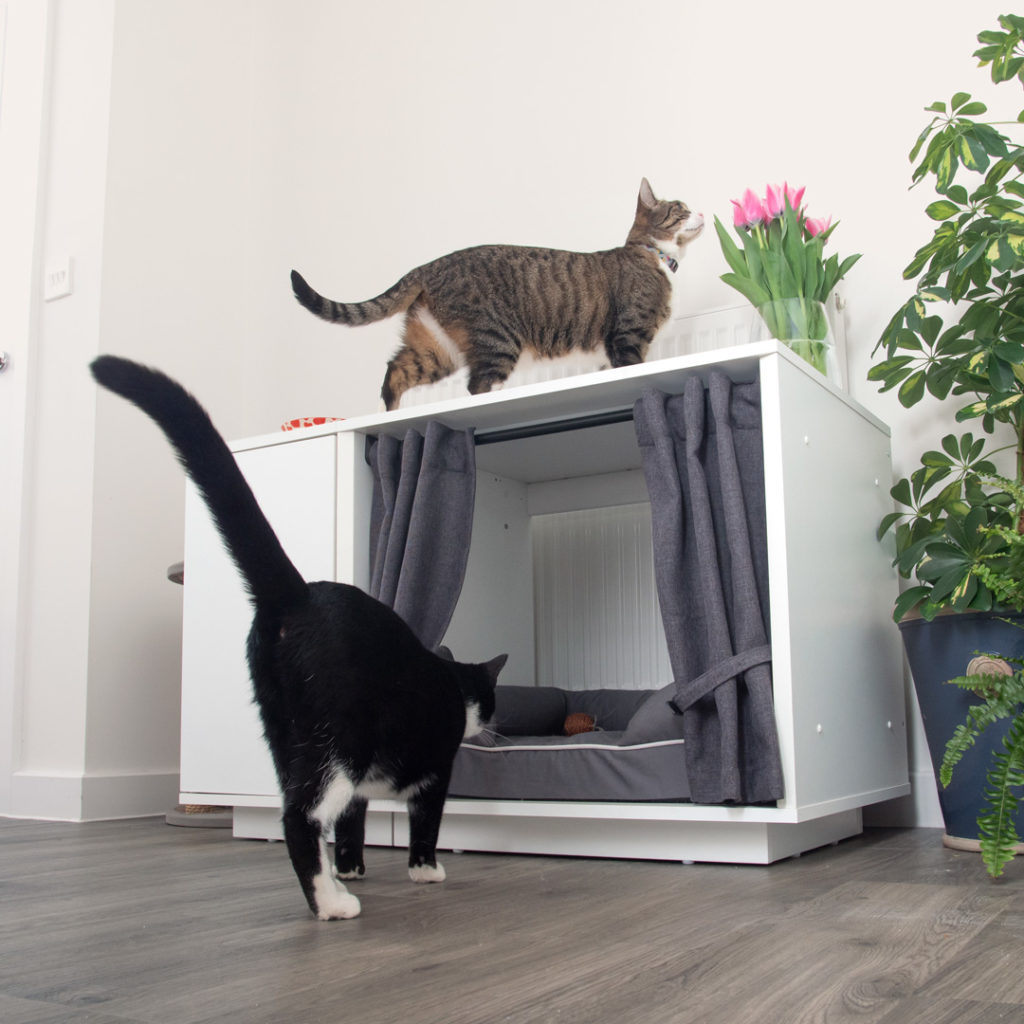
A cat that has lost its tail in an accident, or has injured it in a door or traffic accident, is definitely handicapped. It will not be able to balance as well as before or send out those tail-twitching signals. It is still capable of leading happy life, though – owners just have to look for other body language details to read their pet’s mood.
6 – Inside Story
Cat’s tails have between 19 and 23 vertebrae, depending on the breed (and not counting the tailless Manx!) This represents around 10% of the total number of bones in the cat’s body. These vertebrae give the tail its whiplash flexibility, held together with complex muscles, tendons and ligaments.
7 – Ailing Tails
If your cat is feeling unwell, you can usually see the signs in its tail. It won’t be held upright or twitching excitedly like before. If you notice that the behaviour of your pet’s tail has changed, take it as a sign that she needs a health check. Some cats are prone to dermatitis, sometimes brought on by fleas. This can often be seen in inflamed areas in the region where the tail joins the rump. Some hormonal problems can result in inflammation in the tail too.
8 – Upstanding Felines
The ability to walk with an upright tail is actually unique to domestic cats. All other members of the cat family walk with the tail down, horizontal, or tucked safely between the legs.
9 – Tail End
Cats raise their tails to tell us they’re happy and relaxed, but when prowling amongst other cats the raised tail signal is an invite to come and investigate. Other cats will sniff a cat whose tail is in the air.
It is widely thought that purring is something cats invented just for us – and perhaps that upright happy tail is another one of the ways they won a place in our hearts and homes.
This entry was posted in Cats on June 12th, 2020 by linnearask
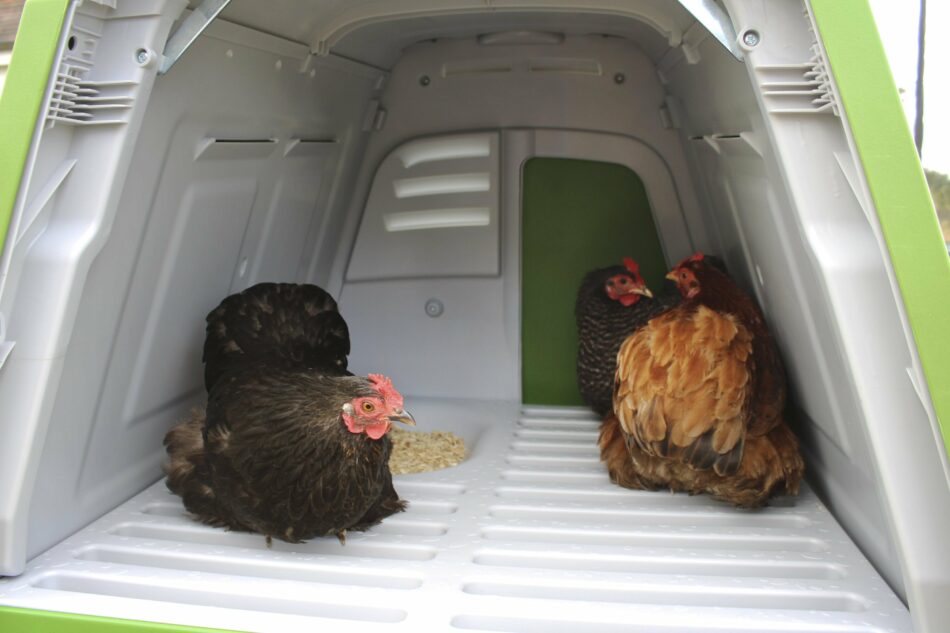
Most hens lay their eggs with minimum fuss. They might make a bit of noise to announce their egg-laying achievement but will soon return to the daily business of exploring and scratching for food. Some hens, however, do make a bit more fuss. To be more accurate, these hens are known as broody. A broody hen is one who sits on her egg with every intention of staying there until it has hatched – no matter whether the egg is fertilised or not. This is very useful if you want to hatch some chicks, but otherwise, it can be a problem. So then, how do you stop a hen from being broody?
The cause of broodiness
The cause of broodiness is linked to body heat, backed up by maternal instincts. Hens who are cooped up together in a hot henhouse may suddenly heat up to a level that makes them think “I’m going to hatch an egg!”. Certain chicken breeds seem more susceptible to broodiness than others, with the Silkies and Cochins being particularly moody-broody.
Signs of broodiness
A broody hen undergoes a personality change. The most obvious sign of this is her refusal to leave the nesting box. She’ll sit there with the air of a bird who will happily wait until Doomsday for the egg to hatch. This misplaced dedication will also make her grumpy and liable to peck or cluck angrily if you try to move her.
When you do manage to oust her from the box, she’ll simply head back there again and resume her brooding. Once she feels established in her new maternal role, she will fluff out her feathers and may begin to self-pluck her chest feathers to line the nest.
How to stop a hen from being broody
Time to get moving
Appearances can be misleading. Your hen may look as though she’ll sit in the box for eternity, but in reality, she’ll only stay there – usually – for three weeks. This is the length of time it takes a chicken egg to hatch. This means, if space allows, you can simply let her brood for 21 days, and once the mood lifts, she’ll return to business as usual. But, if you don’t have a cockerel and don’t want to rear your own chicks, this can be frustrating and you’ll want to break your hen from her broodiness.
You also need to make sure your hen gets enough food and drink during this time, which can be difficult for a hen who doesn’t want to leave their nesting box. This may involve forcibly removing her from the box and shutting it off until she has taken refreshments. Be sure to collect any eggs immediately when you do get the opportunity and be sure to always wear sturdy gloves as a precaution when attempting to move any broody hen. This will prevent your hands from getting pecked!
Try frozen veg
A common anti-broody trick is to place a packet of frozen peas or sweetcorn kernels wrapped in a blanket or tea towel underneath the hen in the nest box. Crushed ice cubes in a bag will do the trick, too. This has the dual impact of cooling the chicken down and making life in the nest box too uncomfortable for brooding.
Nest box obstacle course
Sometimes a simple obstacle such as a plant pot or a couple of bricks will have the desired effect. If the hen can’t access the nest box, she can’t sit there and brood. Fortunately, the Eglu Cube chicken coop has a central divider with a sliding door, which means you’re simply able to close the nest area off from the rest of the coop.
Set up a broody enclosure
Some chicken keepers use a so-called “broody enclosure” to break the habit. This is a wire cage or crate, in which the chicken is placed along with food and water. After three days, this gentle form of solitary confinement will usually break the broody habit. The signs that the brood mood is over are obvious – the hen will stop fluffing out her feathers and will stalk around the cage, rather than sitting and brooding.
Fancy chicks?
Then again, you could purchase some fertilised eggs and let the broody hen resume as she was. If you do want chicks, this is by far the easiest, and most natural way of producing them – under the fluffy belly of a broody hen.
Omlet and your hens
At Omlet, we design products that help find solutions to all your pet questions, like what’s the best coop for a broody hen? With unique products like the Omlet Eglu Cube chicken coop and Walk In Chicken Runs, our expert designers strive to continue creating the best environments for all pets – feathered or furry.


This entry was posted in Chickens on June 10th, 2020 by linnearask

A dog’s sleeping position can tell you many things about your pet that you don’t already know. Our guide to dog sleeping positions helps you identify the way your pup likes to slumber, and what this could indicate.
How much sleep do dogs need a day?
Dogs tend to sleep between 8 – 14 hours a day, whilst puppies need 18 – 20 hours. With so many hours resting in their dog bed, you’re likely to spot many dog sleeping positions whilst your pet is catching up on sleep! How your pet sleeps is just one way to read your dog’s body language, and could help you connect better with your pup.
8 different dog sleeping positions
We’ve put together 8 of the most common sleeping positions for dogs and what they could indicate. From health problems, to demonstrating their comfort around you, decode your puppy’s sleeping habits now.
Curled up in a ball
The position: This is a common sleeping position for wild dogs, who are much more vulnerable than our spoiled pet pooches. The vital organs are protected, the body heat is retained, and the dog can move quickly if needed.
What it means: Dogs that are in an unfamiliar location or experience something that is worrying them will often sleep in this position. To help ease your pet’s worries in new places, bring their familiar and comfy dog crate with you as a safe place for them to nap. However, if your dog prefers to roll up like a fox for nap time it doesn’t necessarily mean that he or she is worried or uncomfortable. They might just like being snuggled in.
Burrowed
The position: A burrowed dog sleeping position is when your pup has nuzzled their way under a blanket, pillows, or even a pile of clothes.
What it means: When opting for this dog sleeping position it shows your pet is looking for comfort or security. If you find your dog is searching for ways to calm themselves down, such as this sleeping position, a comforting dog blanket could help ease anxieties.
Sleeping on their side
The position: The most common sleeping position for dogs is on their side with the legs pointing straight out. Sometimes dogs will fall asleep in a different position, but as soon as the muscles relax and the dog starts to dream, they will automatically roll onto their side.
What it means: This dog’s sleeping position exposes their vital organs. So a dog who prefers to sleep on its side is likely relaxed and comfortable and feels safe with his or her surroundings.
As the legs are free to move in this sleeping position, it is likely that you will see the dog’s legs twitch and kick as they dream.
If your dog favours this position, make sure that their bed is big enough to accommodate their whole body, including the outstretched legs.
Super pup pose
The position: In this dog sleeping position, your pup is on its tummy, with all four legs stretched out. This is very common with puppies who need regular naps, but also always want to be ready to play at any given moment. This is because it’s very easy to get up and going upon waking.
What it means: The Super Pup is almost completely limited to napping; very few dogs spend a whole night in this dog sleeping position. It’s also much more common with smaller dog breeds like terriers and toy breeds, possibly because their limbs are shorter.
On the back, legs up in the air
The position: If your dog is cold, they will curl up into a ball. In a similar way, exposing the belly and spreading out will cool your dog down. Exposing the tummy, where the fur is much thinner, as well as showing the sweat glands on the paws are two of your dog’s best tools to stay cool.
What it means: Comfortable as it may be, it is however a very vulnerable dog sleeping position. The vital organs are exposed, and it will take the dog much longer to get up and go in case of danger than if they had their legs on the ground. If your dog chooses this position even when it’s not boiling hot, it is likely that he or she feels extremely relaxed and comfortable.
Head raised
The position: If your dog is sleeping in a position with their head raised, they’re most likely using the side of a sofa, their dog bed, or even a cushion to prop them up.
What it means: If you find this is a common dog sleeping position for your pet – it could be a sign of dog illness such as breathing difficulties. Keep an eye out for any other symptoms such as fast breathing, and take your dog to a vet if you are concerned.
Close to a human or other pet
The position: Many dogs love falling asleep next to another living thing, preferably really, really close. This behaviour comes from their time as puppies, before they could regulate their own body temperature and had to snuggle up to their siblings to stay warm.
What it means: Although grown dogs don’t need you (or the cat) as a heat source, they have come to associate sleeping next to something warm and breathing with comfort and security. You can be sure that your dog is completely relaxed in your company if he or she decides to sleep right next to you.
Lion’s pose
The position: The lion’s post dog sleeping position is when your pet sleeps with their head resting on their paws. Their back paws will be to one side of their body.
This position is similar to how many lion statues appear.
What it means: When in this dog sleeping position shows that your dog is catching up on sleep, but will be ready to play in seconds. They tend to not be in a deep sleep when lying in this dog sleeping position.

Helping your dog get a good night’s sleep
Ensuring your pet gets a good night’s rest is essential to keep them feeling their best and being ready to play or go on a walk. Ensuring you choose the right size dog bed for your pet could make them as comfy as possible at nap time. Providing them with a blanket could also give them extra comfort. For when the weather gets a little too hot, we recommend giving your pup a dog cooling mat which could help them drift off into a peaceful slumber.
This entry was posted in Dogs on June 4th, 2020 by linnearask
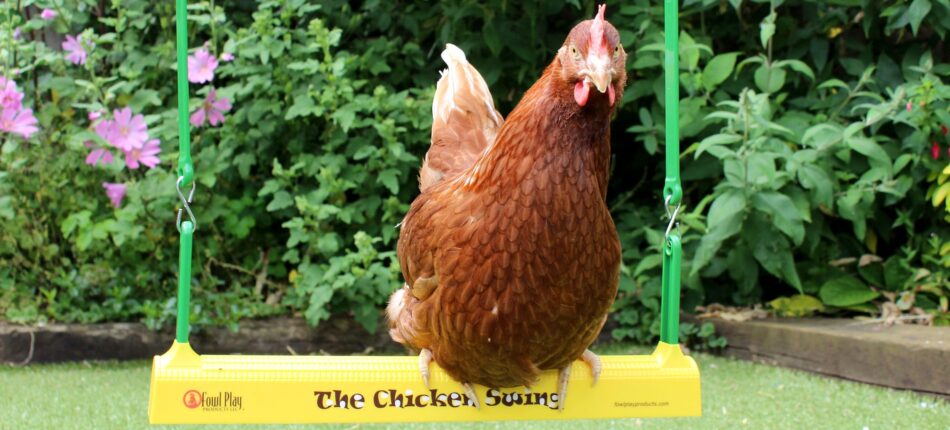
Roosting high up in trees comes natural to chickens, as that is one of the safest places to rest if you’re a chicken in the wild. And doing so on gently moving, or even swinging, branches makes you an even more difficult target for predators. So instinctively your birds should be happy to jump straight up on their Chicken Swing!
With that being said, chickens are vulnerable and clever creatures, which means that they can be wary of new things. They don’t like being the first to try something, so if you’ve got your flock a new toy and are disappointed they don’t seem particularly interested in it, you might have to help them take the leap!
Setting Up The Chicken Swing
The Chicken Swing is cleverly designed to make it as easy as possible for chickens of all ages to use it. The base of the swing has a texture resembling a corncob, which makes it more grippable than a smooth plastic surface.
Make sure you place the swing free from any obstructions such as walls, mesh or other things on the run. Choose a sheltered spot under cover so the hens can do their swinging no matter the weather!
Eventually you ideally want the Chicken Swing to sit above the chickens’ heads, so that they will be able to swing without the risk of bumping into one of their friends. It’s no problem for a chicken to jump up a few feet, but to make it as easy as possible in the beginning, start with the swing close to the ground. The Chicken Swing is lightweight enough that if it were to hit one of your hens, it won’t hurt them.
You won’t need to train all your chickens to get on the swing. They are flock animals, so if you get one of them to show the others how it’s done, there’s a high chance the others will follow shortly!
Letting your chickens have a go
So choose your most adventurous chicken and place her on the swing, which at this stage should be hanging very low to the ground. Give her something delicious straight away, so that she associates the swing with yummy treats. Do this a few times until you feel she’s comfortable perching on the swing. At this point, push the swing slightly to get it moving. Reward the chicken every time she swings towards you. Push a bit more every time you’re trying, and start lifting the Chicken Swing higher and higher above the ground.
If the chicken at any point seems stressed or anxious, stop the training, let her down and go back to basics. It’s important that she only has good feelings associated with the swing!
It’s not guaranteed that all chickens will warm to the swing, it’s just a fact you have to accept. Young chickens are in general more likely to take risks and learn new things, but personality plays a big part, so you’re not automatically going to succeed just because you’re introducing the swing to chicks. However most chicken will, after some persuasion, absolutely love swinging, and it’s worth a bit of work when you see your girls queueing up for their go!

This entry was posted in Chickens on June 2nd, 2020 by linnearask

By becoming an Omlet affiliate you could earn 5% commission from every sale you generate from your website, blog or social media account.
You will put a personal link to our website somewhere on your platform. If someone clicks on the link and goes on to place an order, we will give you your commission!
What are the benefits of the Omlet Affiliate Programme?
- First and foremost, you can earn money from very little effort, and turn your website, blog or email marketing campaigns into an income.
- There are no start-up or running costs, you can start earning straight away.
- You can promote our products without having to carry any inventory, so there is no risk for you.
- All customer communications, shipping and returns are handled by Omlet and our in-house Customer Service Team.
- You can choose which products you advertise to your followers or customers, and how you would like to promote them. You can change links according to season or change a link for a banner whenever you like.
Why advertise Omlet products?
Omlet products are instantly recognisable and unlike anything else on the market in terms of design and quality. We actively work on and invest in brand and product awareness, so that when customers see Omlet products on your platform, it is likely that they have already heard of the brand.
We have a team of product designers who are constantly working on new products, so there will always be something exciting to show your customers or followers.
How do I get started?
Create an Omlet Account and log in here. Click on the ’Affiliate Scheme’ button in the menu on the left hand side of the screen. You will then be able to enter the details for the website where you will post your affiliate links. This can also be a social media account!
Once that is set up an orange banner will appear at the top of the screen when you’re browsing the Omlet website. Visit the page that you would like to link to on your platform, for example the Autodoor page. Click on Link to this page, and the system will create a link and a piece of HTML that you can paste onto your website.
You can also download banners to put on your website. At the moment these are available for Chicken, Cat and Dog products.
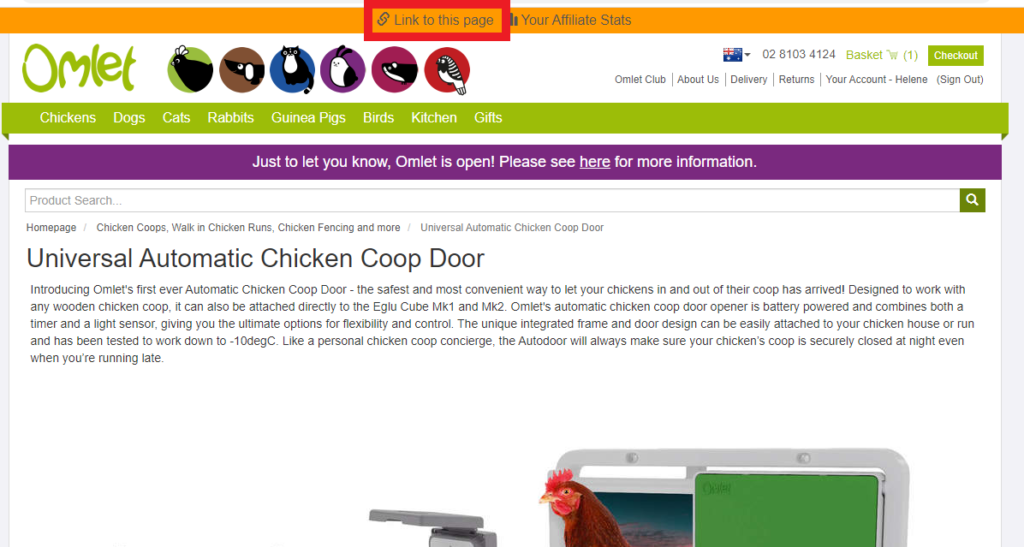

How do you know which orders come from me?
The link you create when you click on the orange banner is unique and it contains information about your website. When someone clicks this link from your site Omlet knows that the person has come from you. Even if they leave the Omlet website and come back again we still know that they originally came from you. This works for up to 60 days from the original click.
You will receive your affiliate commission on anything that the customer purchases on the Omlet website within that 60 day period. The customer doesn’t have to buy the product you are linking to for you to get commission, we will be able to keep track of your Affiliate ID as the customer moves around the website. This means that if they clicked a link about the Autodoor on your site and end up buying an Eglu Go Hutch you will still get your affiliate commission.
You can create as many links as you like to as many pages as you like.
The system will track link clicks, banner views, orders and commission and on your Omlet account you can see where your commissions are coming from and how many clicks different links are getting, which can help you find out what works best.
How do I get paid commission?
When you have earned commission you can request for it to be transferred into your PayPal or bank account. The commission will be paid out 30 days after an order has been dispatched to the referred customer (this is because customers can return a product up to 30 days after receiving it.) Please note that the commission of 5% is calculated on the order value excl. tax, and no commission will be paid on delivery costs.
Do I need a particular type of website to participate?
No, you can add any type of website, blog or social media account as long as it does not host content that is in any way unlawful, harmful, threatening, obscene, harassing, discriminatory, defamatory or otherwise objectionable; facilitates or promotes violence, terrorism, or any other criminal activity; is sexually explicit; or infringes or assists or encourages the infringement of any intellectual property rights belonging to any party.
This entry was posted in Pets on June 2nd, 2020 by linnearask
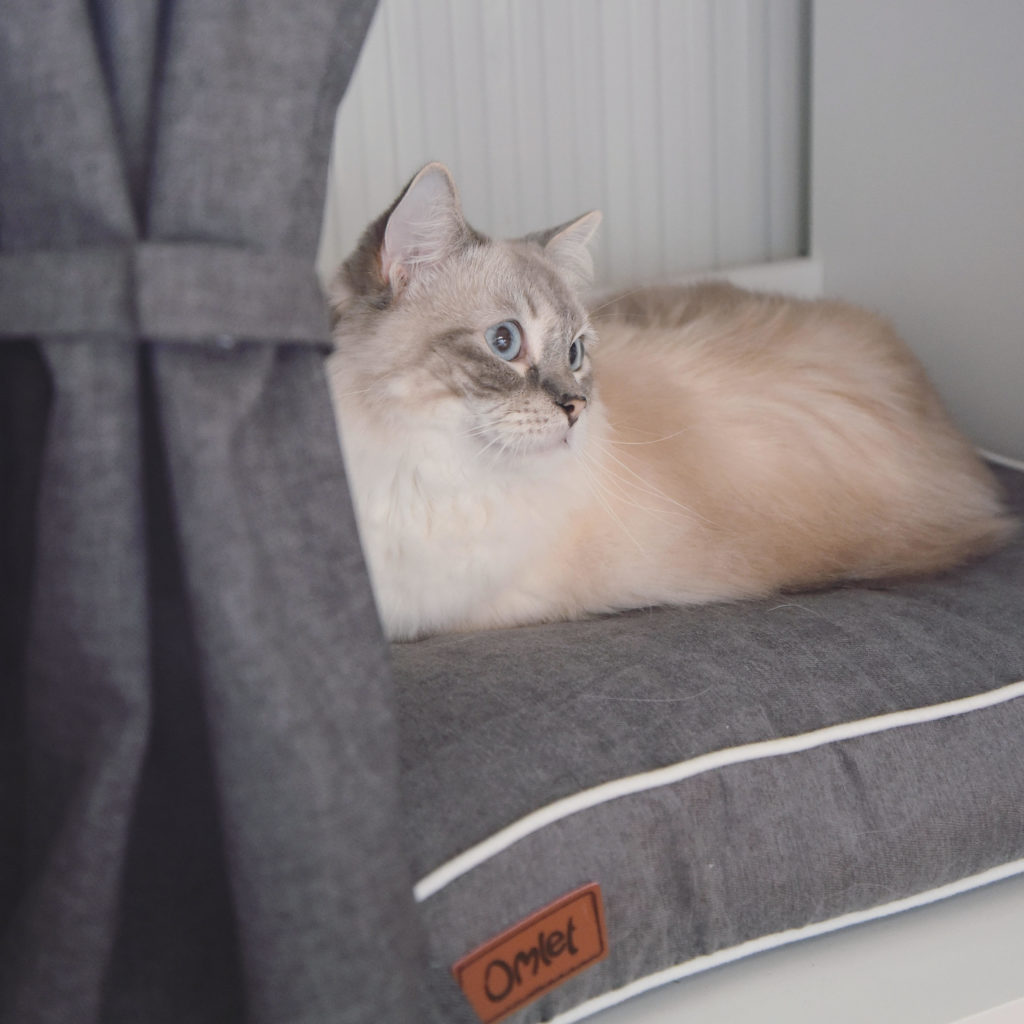 Some cats would rather have an early night on a warm sofa than a long night out on the tiles. The Persian, the Ragdoll and the Russian Blue, for example, all view the world beyond the window as a hazard rather than something irresistible on the other side of the cat flap.
Some cats would rather have an early night on a warm sofa than a long night out on the tiles. The Persian, the Ragdoll and the Russian Blue, for example, all view the world beyond the window as a hazard rather than something irresistible on the other side of the cat flap.
Breeds such as the hairless Sphynx and the thin-coated Cornish Rex and Devon Rex struggle at both ends of the weather scale, burning in strong sunlight and shivering in the cold.
Other breeds, such as Burmese, Korat and Siamese love being outside and will soon become stressed and destructive if forced to live behind closed doors.
Many others mix and match as the mood takes them. For example, you’ll never see an Abyssinian cat more content than when she’s curled up in a favourite armchair – until you’ve seen her rolling blissfully on the lawn.
But no matter where your feline friend sits on the Coach Potato/Great Outdoors scale, one thing they all love is warmth. For an outdoor cat in the UK this is no problem from – let’s be optimistic – the back end of March to the middle of October. But when the temperature drops and the frosty mornings bite, every cat needs somewhere to warm its paws.
An Indoor Haven
You don’t need to have the central heating blasting out to keep your cat from shivering. A cosy spot to curl up in, away from drafts, hustle and bustle, will do the trick. It could be something as simple as a box with a blanket, or a safe space under the cupboard – or even on top of it. Best of all, a tailor-made cat bed will maximise cosiness and heat retention.
Another custom-made option is the Maya Nook. This transforms your cat’s cosy corner into a piece of attractive furniture, providing snuggling space for your pets, and with curtains that keep it all nice and private. The Maya Nook also has an optional wardrobe attachment, for keeping cat food, toys and other feline bits and pieces tidied away.
Even without the heating cranked up, the enclosed nature of the Maya Nook makes it the perfect hot spot at any time of the year.
An Outdoor Haven
If you have the kind of cat who craves the outdoors no matter what the weather, and who sometimes likes to sleep rough in the garden, there are things you can do to make their life a little comfier.
A box-with-a-blanket in a shed or other outbuilding, or a covered area in a quiet corner, can all give the bare minimum of cosiness that no outdoor cat can resist. Even a little dry area under a trampoline or climbing frame can do the trick.
If you have an Omlet Cat Run, you can put a covered snoozing area in one of the corners. That keeps things snug and safe for a cat who likes being outside, but who has a tendency to disappear or wonder into danger.
If your cat still suffers the shivers in winter, you could buy a cat jacket. These can be particularly useful for hairless breeds such as the Sphynx.
Best of all, though, there is that perennial favourite warm spot that can help a cat through the longest of winters – your lap!
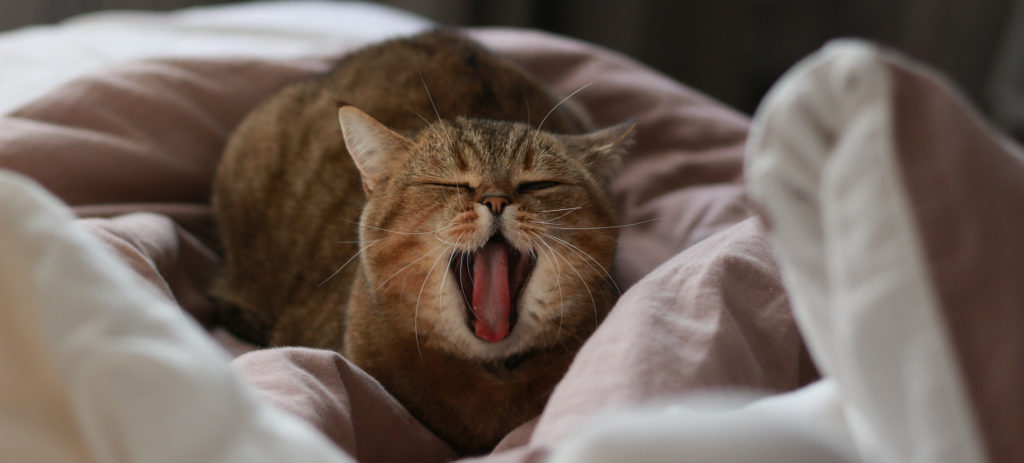
This entry was posted in Cats on June 1st, 2020 by linnearask






















